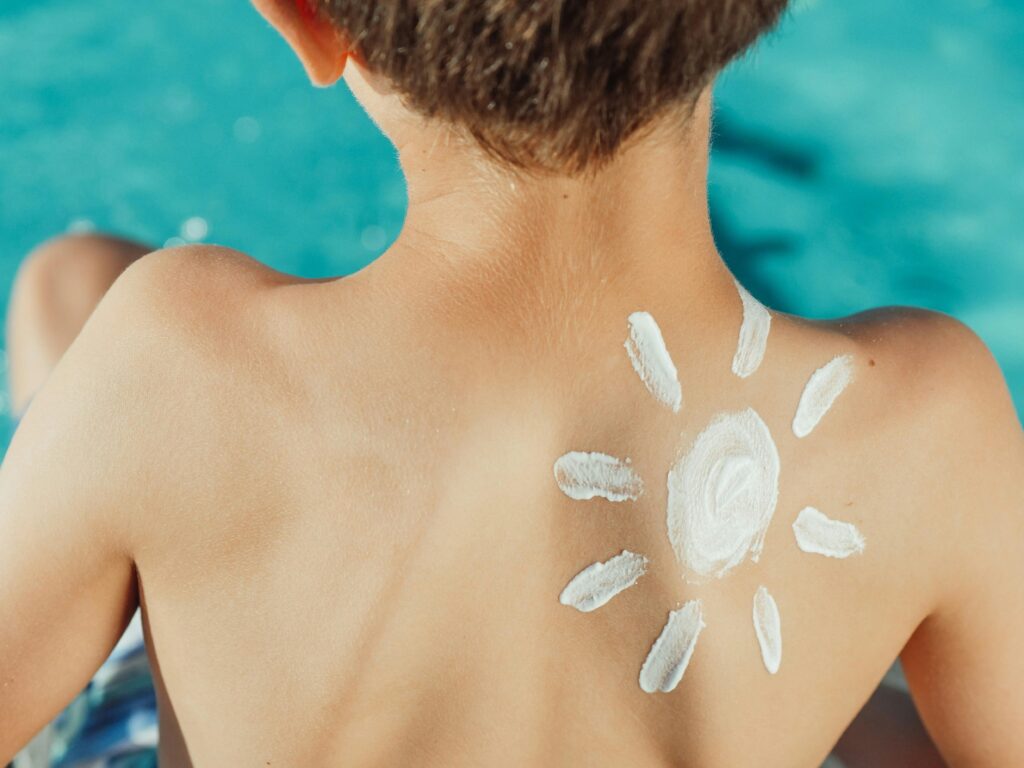Zinc oxide is a key ingredient in many sunscreens. It works by forming a protective layer on your skin to block harmful UV rays. Unlike chemical sunscreens that absorb into your skin, zinc oxide sits on top as a physical barrier.
Zinc oxide sunscreens offer broad-spectrum protection against both UVA and UVB rays. This means they guard against sunburn and long-term skin damage. Mineral-based sunscreens with zinc oxide are often gentler on sensitive skin compared to chemical options.
When you’re shopping for sunscreen, look for products that list zinc oxide as an active ingredient. Many brands now offer lightweight formulas that blend easily without leaving a white cast.
Remember to apply enough and reapply often for the best sun protection.
Understanding Zinc Oxide as a Sunscreen Ingredient
Zinc oxide is a key player in sun protection. It offers wide-ranging benefits for your skin and the environment. Let’s look at how it works and compares to other sunscreen ingredients.
The Role of Zinc Oxide in Broad-Spectrum Protection
Zinc oxide shields your skin from both UVA and UVB rays. This makes it a broad-spectrum protector. It works by sitting on top of your skin and bouncing the sun’s rays away.
Unlike some chemical sunscreens, zinc oxide starts working right away. You don’t need to wait before going outside. It also stays put on your skin, giving you longer-lasting protection.
Zinc oxide is gentle on your skin too. It’s less likely to cause irritation compared to some chemical sunscreens. This makes it a good choice if you have sensitive skin.
Differences Between Zinc Oxide and Titanium Dioxide
Both zinc oxide and titanium dioxide are mineral sunscreens. But they have some key differences:
- Coverage: Zinc oxide protects against a wider range of UV rays than titanium dioxide.
- Appearance: Titanium dioxide tends to leave more of a white cast on your skin.
- Particle size: Non-nano zinc oxide is often used, which some people prefer.
The FDA has found enough safety data on both ingredients to propose them for use in sunscreens.
Pros and Cons of Mineral vs Chemical Sunscreens
Mineral sunscreens (like zinc oxide):
Pros:
- Start working right away
- Less likely to irritate skin
- Better for the environment
Cons:
- Can leave a white cast
- Might feel heavier on skin
Chemical sunscreens:
Pros:
- Often feel lighter on skin
- Don’t leave a white cast
Cons:
- Some may harm coral reefs
- Can irritate sensitive skin
- Need time to start working
Zinc oxide forms a protective barrier on your skin. This physical block is different from how chemical sunscreens work. Your choice depends on your skin type, activities, and personal preferences.
Choosing the Right Sunscreen for Your Skin Type
Picking the best sunscreen for your needs can make a big difference in how well you protect your skin. The right choice depends on your skin type and daily activities.
Formulations Suitable for Sensitive and Acne-Prone Skin
If you have sensitive or acne-prone skin, look for zinc oxide sunscreens. These are less likely to cause irritation. Choose products labeled “non-comedogenic” to avoid clogging pores.
Oil-free options are great for acne-prone skin. They won’t add extra oil to your face. Many brands offer lightweight formulas that feel nice on your skin.
For sensitive skin, try sunscreens with few ingredients. This lowers the chance of a reaction. Some products are made just for sensitive skin types.
Considering Tinted Sunscreen for a Natural Look
Tinted sunscreens can give you sun protection and a bit of color. They’re good for daily use and can replace foundation.
These sunscreens come in different shades to match your skin tone. They can help hide small flaws while protecting you from the sun.
Tinted options are great if you don’t like the white cast some sunscreens leave. They blend in well and look natural.
Sunscreen Options for Daily Facial Use
For everyday face protection, pick a sunscreen that’s light and easy to wear. Look for words like “face sunscreen” or “daily facial sunscreen” on the label.
Many facial sunscreens are made to go under makeup. They soak in quickly and don’t feel greasy. Some even have added skincare benefits.
Water-resistant formulas are good if you sweat a lot or spend time outdoors. They stay on longer and offer better protection.
Ask your doctor or skin expert for advice. They can suggest the best sunscreen for your skin type and needs.
Sunscreen Application and Reapplication Guidelines
Proper sunscreen use is key to protecting your skin from the sun. To get the most benefit, you need to know how to apply sunscreen and when to put on more.
Effective Use of SPF Ratings from SPF 30 to SPF 50+
SPF stands for Sun Protection Factor. It tells you how well a sunscreen blocks UVB rays. SPF 30 blocks 97% of UVB rays, while SPF 50 blocks 98%. The small difference means both are good choices.
Pick broad spectrum SPF 50 for the best protection. This guards against UVA and UVB rays.
Apply a thick layer to all exposed skin. Don’t forget easy-to-miss spots like ears and feet.
Use about 1 ounce (a shot glass full) to cover your whole body. Put sunscreen on 15-30 minutes before going outside. This lets it soak in and start working.
Water-Resistant Sunscreens and Their Importance
Water-resistant sunscreens are great for swimming or sweating. They stay on your skin longer when wet. But they’re not waterproof. You still need to reapply them.
Look for labels that say “water-resistant for 40 minutes” or “water-resistant for 80 minutes”. This tells you how long the sunscreen works while swimming or sweating.
After swimming, dry off and put on more sunscreen. Even if you’re not in water, reapply every 2 hours. Sunscreen wears off over time from sweat, rubbing, and the sun itself.
Strategies to Prevent Sunburn and Long-Term Sun Damage
To avoid sunburn and skin damage, use sunscreen as part of a bigger plan. Apply sunscreen every day, even when it’s cloudy. UV rays can pass through clouds and windows.
Wear protective clothing like long sleeves and hats. Seek shade, especially from 10 AM to 4 PM when the sun is strongest. Use extra care near water, sand, and snow. These surfaces reflect UV rays and increase your exposure.
If you get a sunburn, cool your skin with damp cloths. Drink extra water. Use aloe vera gel to soothe the burn. See a doctor for severe burns or if you feel sick.
Additional Benefits and Considerations of Sunscreen Use
Sunscreens offer more than just UV protection. They can improve skin health, align with ethical values, and provide cutting-edge defense against modern environmental stressors.
Skin Care with Hyaluronic Acid, Niacinamide, and Ceramides
Many sunscreens now include skin-loving ingredients. Hyaluronic acid helps keep your skin hydrated and plump. Niacinamide can even out skin tone and reduce redness. Ceramides support your skin barrier.
These added ingredients turn your sunscreen into a multi-tasking product. You get sun protection plus daily skin care in one step. This can save you time and money.
Some formulas also pack in antioxidants. These fight free radicals from sun exposure and pollution. Look for vitamins C and E on the label.
Environmental and Ethical Aspects of Sunscreen
Your sunscreen choice can impact more than just your skin. Many people now seek out eco-friendly and ethical options.
Reef-safe formulas don’t harm coral reefs. They skip ingredients like oxybenzone and octinoxate. Vegan sunscreens avoid animal-derived ingredients. Cruelty-free brands don’t test on animals.
Some sunscreens use biodegradable packaging. Others offer refillable containers. These choices help reduce plastic waste.
When you pick a sunscreen, think about your values. You can protect your skin while also being kind to the planet.
Advancements in Sunscreen: Blue Light Protection and More
Sunscreens are evolving to meet new challenges. Some now offer blue light protection. This shields your skin from the light emitted by screens and devices.
Broad-spectrum formulas guard against both UVA and UVB rays. This gives you more complete protection.
New textures make sunscreen more pleasant to use. Lightweight, non-greasy formulas feel good on your skin. Tinted options can replace foundation for a natural look.
Sensitive skin? Look for mineral sunscreens with zinc oxide. These tend to be gentler and less likely to cause irritation.
Frequently Asked Questions
Zinc oxide sunscreens offer unique benefits and considerations. Let’s explore some common questions about this popular sun protection ingredient.
What are the benefits of zinc oxide in sunscreens?
Zinc oxide provides broad-spectrum protection against both UVA and UVB rays. It starts working right away and doesn’t break down in sunlight.
This mineral sunscreen is gentle on sensitive skin. It rarely causes irritation or allergic reactions.
How does zinc oxide sunscreen compare to those with other active ingredients?
Zinc oxide is a physical sunscreen. It sits on top of your skin to block UV rays.
Chemical sunscreens absorb into your skin. They work by changing UV rays into heat.
Physical sunscreens like zinc oxide are often better for sensitive skin. They’re less likely to cause reactions.
Can zinc oxide in sunscreen be harmful or cause cancer?
Zinc oxide in sunscreen is safe to use. There’s no evidence that it causes cancer.
In fact, using zinc oxide sunscreen helps prevent skin cancer. It protects you from harmful UV rays that can damage your skin.
What should I consider when choosing a zinc oxide sunscreen for my face?
Look for a sunscreen that’s non-comedogenic. This means it won’t clog your pores.
Choose a product with at least SPF 30. Make sure it’s labeled “broad-spectrum” to protect against both UVA and UVB rays.
If you have oily skin, try a lightweight or gel formula. For dry skin, pick a more moisturizing option.
Does the skin absorb zinc oxide from sunscreen products?
Zinc oxide mostly stays on the surface of your skin. It doesn’t absorb much into your body.
This is one reason why zinc oxide is often recommended for children and people with sensitive skin.
Are there any major disadvantages to using sunscreens that contain zinc oxide?
Some zinc oxide sunscreens can leave a white cast on your skin. This can be more noticeable on darker skin tones.
Zinc oxide sunscreens might feel thicker or greasier than chemical sunscreens. However, many newer formulas are more lightweight and easier to apply.
These sunscreens can be a bit pricier than chemical options. However, many people feel the benefits are worth the cost.



